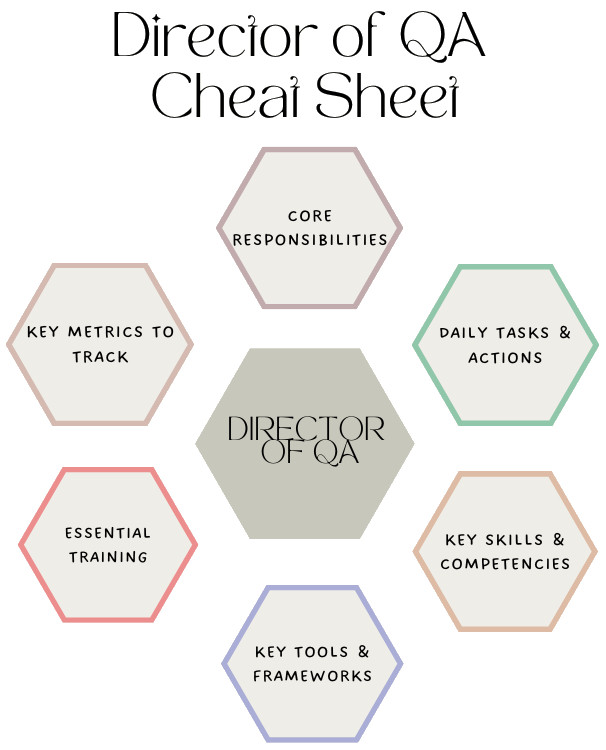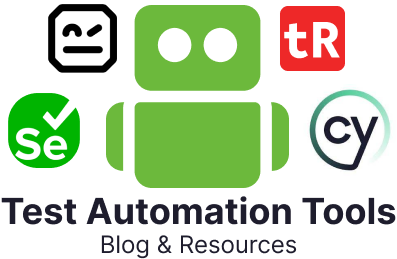A Director of Quality Assurance (QA) is an integral part of an organization’s management. The person plays the role of primary spokesperson for QA across the organization. The Director of QA plays a crucial role in ensuring that software products meet the highest standards of usability, performance, and reliability. A Director of QA also oversees the strategy and vision, making sure that the product quality aligns with industry standards.
Naturally, the role requires strong leadership, communication skills, and technical proficiency to effectively lead the teams, manage resources, and make well-informed decisions.
In this article, we present a Director of QA cheat sheet that serves as a strategic and operational guide for anyone stepping into or currently serving in this role.

Core Responsibilities
| Responsibilities | Description |
|---|---|
| Team Leadership, Management, & Development |
|
| Process Ownership | |
| Strategic Planning & Vision |
|
| Stakeholder Collaboration |
|
| Risk Management |
|
| Budget Management |
|
| Continuous Improvement |
|
Daily Tasks & Actions
| Tasks & Actions | Description |
|---|---|
| Regular Team Meetings |
|
| Performance Management |
|
| Issue Tracking |
|
| Reporting |
|
| Staying Updated |
|
Key Skills & Competencies
| Skills | Description |
|---|---|
| Leadership & Management |
|
| Technical Proficiency |
|
| Problem-Solving |
|
| Communication |
|
| Critical Thinking & Decision-Making |
|
| Resource Management |
|
| Negotiation |
|
Key Tools & Frameworks
| Tools Category | Tools/Frameworks |
|---|---|
| Test Management | TestRail, Zephyr, qTest, PractiTest |
| Test Automation | testRigor, Selenium, Cypress, Playwright |
| CI/CD | Jenkins, GitHub Actions, CircleCI |
| Bug Tracking | Jira, Bugzilla, Linear |
| Performance Testing | JMeter, Gatling, k6 |
| Monitoring | Datadog, New Relic, Sentry |
| Collaboration &Communication | Slack, Microsoft Teams, Zoom |
| Documentation & Collaboration | Confluence, Google Workspace |
| Analytics & Reporting | Tableau, Power BI |
Essential Training
| Training Category | Description |
|---|---|
| Agile/Scrum Methodologies | Understand Agile principles and how QA fits into iterative development. |
| Test Automation | Master automation frameworks, scripting languages, and tools (e.g., testRigor, Selenium, Appium, JUnit). |
| CI/CD | Understand the concepts of continuous integration and continuous development pipelines for frequent releases and continuous testing. |
| Quality Management Systems (QMS) | Familiarize with QMS frameworks like ISO 9001 if and when relevant. |
| Performance Testing | Learn and gain expertise in tools like JMeter or Gatling for load and performance testing. |
| Leadership and Management | Enhance leadership skills through workshops and courses. |
| Communication and Collaboration | Attend courses to improve communication and collaboration skills. |
Key Metrics to Track
| Metrics | Details |
|---|---|
| Operational Metrics |
|
| Business Impact Metrics |
|
Common Designations
- Quality Head
- Head of QA
- Senior Manager QA
- Director QA
- Lead/Manager- Quality Assurance
- Director of QA Practices
- Head of TCOE
- Head of Testing
Automation Strategy Guide
The Director of QA may follow this automation strategy guide for effective test automation:
- First and foremost, have a test plan and strategy in place for the project at hand. They may likely urge their managers and leads to work on this.
- Maintain a test pyramid of testing types such that testing is completed step-by-step. For example, conduct unit testing followed by integration and then UI testing. They can use this to divide and conquer – test (manually or via automation) these different aspects of the application.
- Start with critical user paths and frequent regression tests to ensure all features work correctly.
- Incorporate cross-browser/platform scenarios when testing the application.
- Use data-driven testing for scalability purposes.
- Make use of test mocks/stubs for performance and isolation.
- Consider negative scenarios and error handling too.
- Automate testing wherever possible.
- Regularly gather test reports to keep track of QA endeavors. If something seems off, they may look for improvements in existing processes and implementations.
While a Director of QA may not directly be the one automating and testing applications, they are responsible for setting the tone and providing guidance to their teams. This high-level strategy is meant to help with that.
Strategic Focus Areas
The following are some of the strategic areas a Director of QA should focus on:
- Scaling Automation: Reusability, maintainability, and parallel execution should be encouraged and maintained..
- AI in QA: Use of AI in test creation and maintenance should be encouraged. Use tools like testRigor for this purpose.
- Security Testing Integration: Embed SAST/DAST into QA flows to test the security aspect.
- Compliance: Ensure SOC2, ISO, GDPR, and HIPAA validation where needed to comply with them.
- Customer Experience: Correlate bugs with UX issues and NPS data from the customer.
To Summarize
The role of Director of QA is a leadership role and plays a crucial part in QA management as a whole. The QA leaders should exhibit the following capabilities:
- Be Outcome-Oriented: Focus should be on business value, and not just bug counts.
- Communicate with Data: Highlight risks and progress using dashboards and storytelling.
- Empower Your Team: Trust your leads and encourage innovation.
- Lead Through Change: Champion quality transformation in legacy or fast-growing orgs.
- Stay Curious: Follow QA trends, communities, and conferences to stay up-to-date with the latest happenings in QA.
This cheat sheet is the roadmap to mastering the responsibilities, acquiring the skills, using available resources, and utilizing the tools necessary to excel as a Director of QA.
